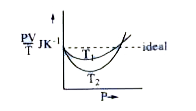The respective speeds of five molecules are 2, 1.5, 1.6, 1.6 and 1.2 km/sec. The most probable speed in km/sec will be Solution in Telugu
2
1.58
1.6
1.31
The correct Answer is:C
Step by step video, text & image solution for The respective speeds of five molecules are 2, 1.5, 1.6, 1.6 and 1.2 km/sec. The most probable speed in km/sec will be by Physics experts to help you in doubts & scoring excellent marks in Class 11 exams.
Updated on:21/07/2023Topper's Solved these Questions
- KINETIC THEORY OF GASESBOOK - AAKASH SERIESCHAPTER - KINETIC THEORY OF GASESEXERCISE - EXERCISE-3(Kinetic Theory of an ideal gas)
4 Videos
- KINETIC THEORY OF GASESBOOK - AAKASH SERIESCHAPTER - KINETIC THEORY OF GASESEXERCISE - EXERCISE-3(Various speed of gas molecules)
10 Videos
- KINETIC THEORY OF GASESBOOK - AAKASH SERIESCHAPTER - KINETIC THEORY OF GASESEXERCISE - EXERCISE-IB(Theoretical Questions)
29 Videos
- KINEMATICSBOOK - AAKASH SERIESCHAPTER - KINEMATICSEXERCISE - ADDITIONAL PRACTICE EXERCISE (PRACTICE SHEET (ADVANCED)) (Integer Type Questions)
12 Videos
- LAWS OF MOTIONBOOK - AAKASH SERIESCHAPTER - LAWS OF MOTIONEXERCISE - PRACTICE EXERCISE
108 Videos
Similar Questions
Given is the graph between PV/T and P for 1 gm of oxygen gas at two different temperature T1 and T2 (Given:Density of oxygen=1.429kg/m3).The value of PV/T at the point A and the relation between T1 and T2 and respectively

View SolutionFour particles have speed 2,3,4 and 5 cm/s respectively. Their rms speed is :
View Solution(A): The total translational kinetic energy of all the molecules of a given mass of an ideal gas is 1.5 times the product of its pressure and its volume.
(R): The molecules of a gas collide with each other and the velocities of the molecules change due to the collision.
View SolutionThree particles start from origin at the same time: one with velocity v1 along positive x - axis, the second along the positive y-axis with a velocity v2 and the third along the line y=x with such a speed that all the three always stay in a straight line, then the velocity of the third particle is √kV1V2(V1+V2).
View SolutionA force of 50 N acts on a body of mass 10 kg at rest. Its velocity after 5 seconds if the same force acts, is
View SolutionFour molecules of a gas have speed 1, 2, 3 and 4 km s^(-1) respectively. The value of rms speed of the molecules is (in km s^(-1) )
View SolutionFive molecules of a gas have speed 2, 4, 6, 8 km//s . Calculate average speed. Rms speed and most probable speed of these molecules.
View SolutionThe respective speeds of five molecules are 2,1.5,1.6,1.6 and 1.2 km/sec. The most probable speed in km/sec will be
View SolutionIn a certain sample of gas at 25∘C the number of molecules having speeds between 4 km sec−1 and 4.1 km sec−1 is N. if the total number of gas molecules at the same temperature are doubled what will happen?
View SolutionThe respective speeds of five molecules are 2, 1.5, 1.6, 1.6 and 1.2 km/sec. The most probable speed in km/sec will be:
View Solutionthe r.m.s. velocity of the molecules of a certain diatomic gas is found to be 1.6 Km/sec. the gas is
View Solutionपाँच अणुओं की चाल क्रमश: 2, 1.5, 1.6, 1.6 और 1.2 किमी/से है। उसकी सर्वाधिक प्रसम्भाव्य चाल होगी (किमी/से में)
View SolutionThe most probable velocity of the molecules of a gas is 1 km/sec. The R.M.S velocity of the molecules is
View SolutionThe most probable velocity of the molecules of a gas is 1 km/sec. The R.M.S velocity of the molecules is
View SolutionThe respective speeds of five molecules are 2, 1.5, 1.6, 1.6 and 1.2 km/sec. The most probable speed in km/sec will be
View SolutionThe respective speeds of the molecules are 1, 2, 3, 4 and 5 km/sec. The ratio of their r.m.s velocity and the average velocity will be
View Solution
